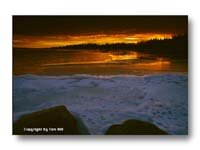

All Images And Text On This Site Are Copyright 1999-2000
by
Thomas D. Hill Jr.
October, 2000
Fall to Winter Transformation
| ABOUT KEIKO |
| WHAT'S NEW |
| THE KEIKO GALLERY |
| EQUIPMENT |
| IMAGE OF THE MONTH |
| ARTICLE OF THE MONTH |

Up here in Eastern Alberta, the winter hits hard. During the depth of this season, the temperatures can range a low as -40 deg (C or F). Before the arctic conditions set in, the summer gives way to fall and all to quickly to the winter. In a span of only days, the moderate temperatures of early fall drop to summon the impending arrival of winter. In only two days, shorts and shortsleves are packed away while winter jackets, gloves, and hats are pulled out of storage. It's a quick transition but not all moves as quickly.
Since Cold Lake possesses such a large quantity of water, it doesn't freeze until months after the temperatures had dropped permanently below freezing. The contrast of snow and water is evident throughout the region. During particularly cold mornings--0 deg F--the lake seems to be an ice fog producer. Small snow squalls are evident during this time and occasionally large accumulations of snow is possible.
Still, despite all this water, the cold eventually wins. The lake freezes over and the drama of the fall to winter transition ends.

As the transition occurs, the ice slowly surrounds the outskirts of the lake letting the middle churn and fight back against the freezing temperatures. The above image was taken the day prior to "freeze up". Though the water looks inviting in the sunset, it's killer cold. Only a couple more days of freezing temperatures will cause the lake to finally become solid. It's quite an interesting occurrence.
"Freeze Up" takes a day. One day, you're fighting the ice fog and mist caused by the open water. The next day, the lake is frozen solid from end to end. I think it's something of a thermodynamics demonstration where the warm water below a thermal inversion finally is released allowing the surface energy to lower enough to allow ice to form. In a matter of hours, the entire lake becomes covered with the virgin ice.


This image shows the morning after "freeze up". The surface is essentially solid though some liquid still hasn't frozen. The surface isn't solid enough to walk on yet, but it wasn't long before folks were out driving their vehicles on the lake for ice fishing. I don't trust my interpretation of the ice conditions enough to risk a fall through. So, I waited several days before embarking out on the ice.
Cold Lake is a wonderful place during the transition season. Changing from liquid to solid is interesting and wonderful in a thermodynamics sense. Why it only takes a day to change escapes me. But, it does.
Cheers
Tom